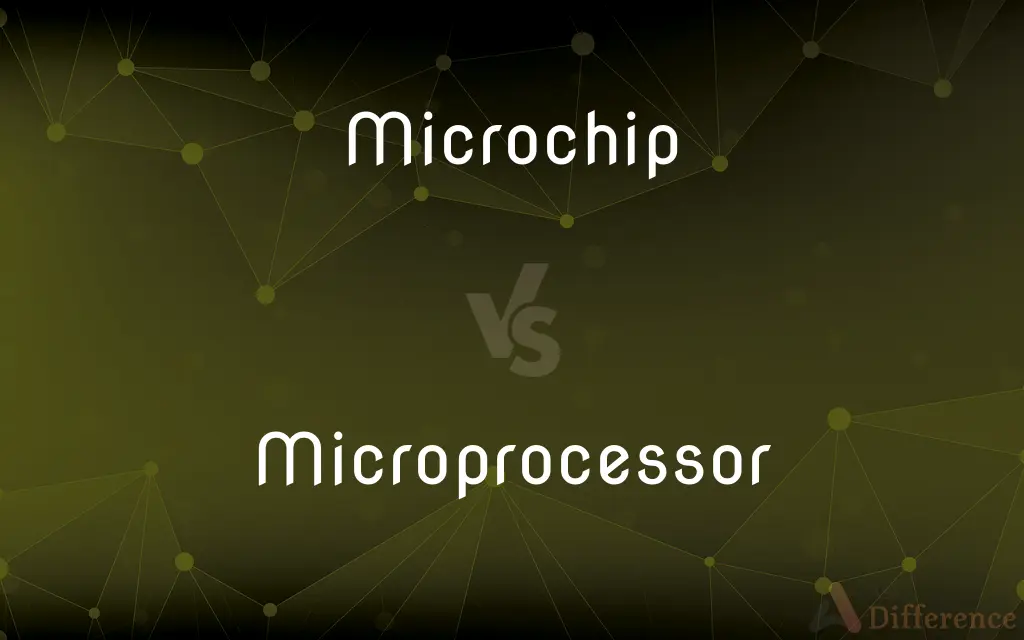Microchip vs. Microprocessor — What's the Difference?
By Urooj Arif & Fiza Rafique — Updated on March 31, 2024
A microchip is a small semiconductor device containing electronic circuits, while a microprocessor is a specific type of microchip designed to execute a wide range of instructions.

Difference Between Microchip and Microprocessor
Table of Contents
ADVERTISEMENT
Key Differences
A microchip, broadly defined, is a compact set of electronic circuits on a small piece of semiconductor material, usually silicon. It can serve a myriad of functions depending on its design, from simple tasks like storing data to complex processing. On the other hand, a microprocessor is a specialized microchip that acts as the central processing unit (CPU) of a computer, interpreting and executing program instructions, performing calculations, and managing data flow.
Microchips encompass a wide range of electronic devices, including microprocessors, memory chips, and integrated circuits (ICs) used for various applications in electronics and computing. While all microprocessors are microchips, not all microchips are microprocessors. This distinction is crucial in understanding their roles in technology. Microprocessors, with their ability to process complex sets of instructions, are key components in computers, smartphones, and other programmable devices.
In terms of complexity, microprocessors are among the most complex types of microchips, containing millions or even billions of transistors. These transistors work together to perform operations and execute instructions. In contrast, other microchips, such as those used for digital storage or simple logic circuits, may contain far fewer transistors and are designed for more specific, less complex tasks.
The design process between microchips and microprocessors also differs significantly. Designing a microprocessor involves extensive planning around its architecture, instruction set, and integration with other computer components. Other types of microchips, while still complex, can be designed with more focused applications in mind, such as amplifying a signal or converting digital data to analog form.
The impact of microprocessors on the development of modern computing and electronics cannot be overstated. They are the brains behind the operation of PCs, smartphones, and servers, driving the processing power of these devices. Other microchips, while essential for various functions within electronic devices, do not typically perform such a wide range of tasks or process data independently.
ADVERTISEMENT
Comparison Chart
Definition
Small semiconductor device containing electronic circuits.
A specialized microchip that functions as the CPU of a computer.
Types
Includes microprocessors, memory chips, and other ICs.
A specific category of microchip.
Complexity
Can range from simple to complex.
Typically very complex, containing millions to billions of transistors.
Function
Varies widely, from data storage to processing signals.
Executes program instructions and processes data.
Design Focus
Specific applications, such as signal amplification or data conversion.
Architecture and instruction set for versatile data processing.
Compare with Definitions
Microchip
Serves various functions in electronic devices.
Microchips in a smartphone handle tasks from processing to memory storage.
Microprocessor
A CPU on a single chip, central to computing processes.
The computer's performance is largely determined by its microprocessor.
Microchip
A compact electronic device consisting of integrated circuits.
The RFID tag uses a microchip to store identification data.
Microprocessor
Executes a wide range of instructions for data processing.
The microprocessor processes user commands in real-time.
Microchip
Tailored for specific functions within a system.
The microchip in a digital thermometer precisely measures temperature.
Microprocessor
Contains a high number of transistors for multitasking.
Modern microprocessors integrate billions of transistors for enhanced performance.
Microchip
From simple logic circuits to complex processing units.
A simple LED driver microchip controls light intensity.
Microprocessor
Found in computers, smartphones, and servers.
Servers use advanced microprocessors to manage large volumes of data.
Microchip
Integral to nearly all modern electronics.
Wearable devices use microchips for both sensing and data processing.
Microprocessor
Engineered for general or specific computing tasks.
The microprocessor's architecture is optimized for efficient data analysis.
Microchip
A small, thin piece of semiconductor bearing numerous circuits integrated into its substrate. A chip smaller than a fingernail can hold millions of circuits. Most of a computer's circuitry is built from chips mounted on circuit boards. Also called chip.
Microprocessor
A microprocessor is a computer processor wherein the data processing logic and control is included on a single integrated circuit, or a small number of integrated circuits. The microprocessor contains the arithmetic, logic, and control circuitry required to perform the functions of a computer’s central processing unit.
Microchip
To implant a microchip in
All of the animals in this shelter have been microchipped.
Microprocessor
An integrated circuit that contains a major processing unit of a computer on a single microchip, such as the central processor or the graphics processor.
Microchip
Integrated circuit; microprocessor.
Microprocessor
(computer hardware) the entire CPU of a computer on a single integrated circuit (chip).
Microchip
(transitive) To fit (an animal) with a microchip.
Microprocessor
Integrated circuit semiconductor chip that performs the bulk of the processing and controls the parts of a system;
A microprocessor functions as the central processing unit of a microcomputer
A disk drive contains a microprocessor to handle the internal functions of the drive
Microchip
Electronic equipment consisting of a small crystal of a silicon semiconductor fabricated to carry out a number of electronic functions in an integrated circuit
Common Curiosities
Why are microprocessors considered the "brain" of computers?
Microprocessors perform the critical calculations and data processing that allow computers to run software and perform tasks.
Can a device function without a microprocessor?
Yes, many electronic devices function without microprocessors, using other types of microchips for specific tasks.
How do microchips store data?
Microchips designed for storage, like memory chips, store data using transistors and capacitors in various configurations.
What advances have microprocessors made possible?
Microprocessors have enabled the development of complex computing systems, smartphones, and advanced electronics, transforming how we interact with technology.
What's the main difference between a microchip and a microprocessor?
A microchip is a broad category of semiconductor devices, while a microprocessor is a specific type of microchip designed to execute instructions and process data.
Can microprocessors be customized for specific applications?
Yes, microprocessors can be designed with specific features and instruction sets for targeted applications, such as embedded systems.
Are all microchips made of silicon?
While silicon is the most common material due to its semiconducting properties, other materials can also be used for specific types of microchips.
How does a microprocessor interpret instructions?
A microprocessor interprets instructions through its control unit, which decodes and executes commands based on its instruction set.
What is a microcontroller, and how does it differ from a microprocessor?
A microcontroller is a type of microchip that includes a microprocessor along with memory and other peripherals on a single chip, designed for specific control tasks.
How has the design of microprocessors evolved?
Microprocessor design has evolved to include more cores, higher speeds, and greater efficiency, accommodating the growing demand for processing power.
What's next for microprocessor technology?
Future developments may include quantum computing, 3D stacking of chips for higher performance, and further miniaturization for wearables and implantable devices.
What role do microchips play in IoT devices?
Microchips in IoT devices facilitate communication, data processing, and control functions, enabling smart features and connectivity.
What challenges are involved in microprocessor design?
Challenges include managing heat dissipation, increasing transistor density, and improving energy efficiency.
How do advancements in microchip technology affect consumer electronics?
Advances in microchip technology lead to faster, more efficient, and more capable consumer electronics, from smartphones to home appliances.
Can microchips be recycled or repurposed?
While challenging due to their small size and complex materials, efforts are being made to recycle and repurpose microchips for environmental sustainability.
Share Your Discovery

Previous Comparison
Experience vs. Perception
Next Comparison
Demolish vs. DemolitionAuthor Spotlight
Written by
Urooj ArifUrooj is a skilled content writer at Ask Difference, known for her exceptional ability to simplify complex topics into engaging and informative content. With a passion for research and a flair for clear, concise writing, she consistently delivers articles that resonate with our diverse audience.
Co-written by
Fiza RafiqueFiza Rafique is a skilled content writer at AskDifference.com, where she meticulously refines and enhances written pieces. Drawing from her vast editorial expertise, Fiza ensures clarity, accuracy, and precision in every article. Passionate about language, she continually seeks to elevate the quality of content for readers worldwide.














































